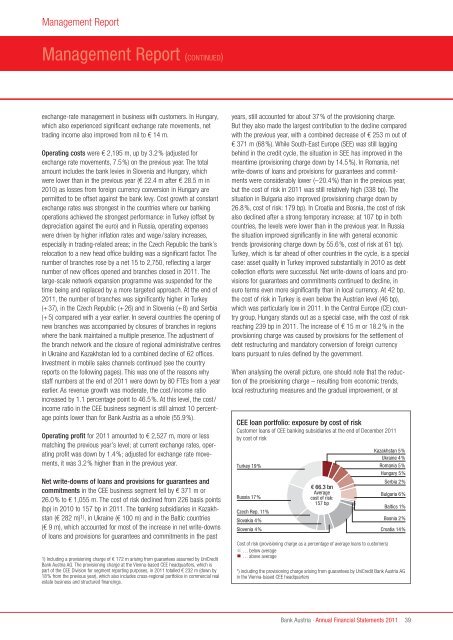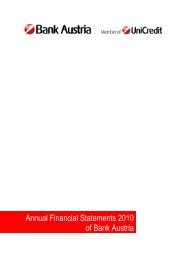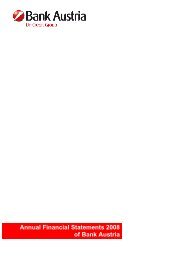Annual Financial Statements 2011 of Bank Austria
Annual Financial Statements 2011 of Bank Austria
Annual Financial Statements 2011 of Bank Austria
Create successful ePaper yourself
Turn your PDF publications into a flip-book with our unique Google optimized e-Paper software.
Management Report<br />
Management Report (CONTINUED)<br />
exchange-rate management in business with customers. In Hungary,<br />
which also experienced significant exchange rate movements, net<br />
trading income also improved from nil to € 14 m.<br />
operating costs were € 2,195 m, up by 3.2% (adjusted for<br />
exchange rate movements, 7.5%) on the previous year. The total<br />
amount includes the bank levies in Slovenia and Hungary, which<br />
were lower than in the previous year (€ 22.4 m after € 28.5 m in<br />
2010) as losses from foreign currency conversion in Hungary are<br />
permitted to be <strong>of</strong>fset against the bank levy. Cost growth at constant<br />
exchange rates was strongest in the countries where our banking<br />
operations achieved the strongest performance: in Turkey (<strong>of</strong>fset by<br />
depreciation against the euro) and in Russia, operating expenses<br />
were driven by higher inflation rates and wage/salary increases,<br />
especially in trading-related areas; in the Czech Republic the bank’s<br />
relocation to a new head <strong>of</strong>fice building was a significant factor. The<br />
number <strong>of</strong> branches rose by a net 15 to 2,750, reflecting a larger<br />
number <strong>of</strong> new <strong>of</strong>fices opened and branches closed in <strong>2011</strong>. The<br />
large-scale network expansion programme was suspended for the<br />
time being and replaced by a more targeted approach. At the end <strong>of</strong><br />
<strong>2011</strong>, the number <strong>of</strong> branches was significantly higher in Turkey<br />
(+37), in the Czech Republic (+26) and in Slovenia (+8) and Serbia<br />
(+5) compared with a year earlier. In several countries the opening <strong>of</strong><br />
new branches was accompanied by closures <strong>of</strong> branches in regions<br />
where the bank maintained a multiple presence. The adjustment <strong>of</strong><br />
the branch network and the closure <strong>of</strong> regional administrative centres<br />
in Ukraine and Kazakhstan led to a combined decline <strong>of</strong> 62 <strong>of</strong>fices.<br />
Investment in mobile sales channels continued (see the country<br />
reports on the following pages). This was one <strong>of</strong> the reasons why<br />
staff numbers at the end <strong>of</strong> <strong>2011</strong> were down by 80 FTEs from a year<br />
earlier. As revenue growth was moderate, the cost/income ratio<br />
increased by 1.1 percentage point to 46.5%. At this level, the cost/<br />
income ratio in the CEE business segment is still almost 10 percentage<br />
points lower than for <strong>Bank</strong> <strong>Austria</strong> as a whole (55.9%).<br />
operating pr<strong>of</strong>it for <strong>2011</strong> amounted to € 2,527 m, more or less<br />
matching the previous year’s level; at current exchange rates, operating<br />
pr<strong>of</strong>it was down by 1.4%; adjusted for exchange rate movements,<br />
it was 3.2% higher than in the previous year.<br />
net write-downs <strong>of</strong> loans and provisions for guarantees and<br />
commitments in the CEE business segment fell by € 371 m or<br />
26.0% to € 1,055 m. The cost <strong>of</strong> risk declined from 226 basis points<br />
(bp) in 2010 to 157 bp in <strong>2011</strong>. The banking subsidiaries in Kazakhstan<br />
(€ 282 m) 1), in Ukraine (€ 100 m) and in the Baltic countries<br />
(€ 9 m), which accounted for most <strong>of</strong> the increase in net write-downs<br />
<strong>of</strong> loans and provisions for guarantees and commitments in the past<br />
1) Including a provisioning charge <strong>of</strong> € 172 m arising from guarantees assumed by UniCredit<br />
<strong>Bank</strong> <strong>Austria</strong> AG. The provisioning charge at the Vienna-based CEE headquarters, which is<br />
part <strong>of</strong> the CEE Division for segment reporting purposes, in <strong>2011</strong> totalled € 232 m (down by<br />
18% from the previous year), which also includes cross-regional portfolios in commercial real<br />
estate business and structured financings.<br />
years, still accounted for about 37% <strong>of</strong> the provisioning charge.<br />
But they also made the largest contribution to the decline compared<br />
with the previous year, with a combined decrease <strong>of</strong> € 253 m out <strong>of</strong><br />
€ 371 m (68%). While South-East Europe (SEE) was still lagging<br />
behind in the credit cycle, the situation in SEE has improved in the<br />
meantime (provisioning charge down by 14.5%). In Romania, net<br />
write-downs <strong>of</strong> loans and provisions for guarantees and commitments<br />
were considerably lower (–20.4%) than in the previous year,<br />
but the cost <strong>of</strong> risk in <strong>2011</strong> was still relatively high (338 bp). The<br />
situation in Bulgaria also improved (provisioning charge down by<br />
26.8%, cost <strong>of</strong> risk: 179 bp). In Croatia and Bosnia, the cost <strong>of</strong> risk<br />
also declined after a strong temporary increase; at 107 bp in both<br />
countries, the levels were lower than in the previous year. In Russia<br />
the situation improved significantly in line with general economic<br />
trends (provisioning charge down by 55.6%, cost <strong>of</strong> risk at 61 bp).<br />
Turkey, which is far ahead <strong>of</strong> other countries in the cycle, is a special<br />
case: asset quality in Turkey improved substantially in 2010 as debt<br />
collection efforts were successful. Net write-downs <strong>of</strong> loans and provisions<br />
for guarantees and commitments continued to decline, in<br />
euro terms even more significantly than in local currency. At 42 bp,<br />
the cost <strong>of</strong> risk in Turkey is even below the <strong>Austria</strong>n level (46 bp),<br />
which was particularly low in <strong>2011</strong>. In the Central Europe (CE) country<br />
group, Hungary stands out as a special case, with the cost <strong>of</strong> risk<br />
reaching 239 bp in <strong>2011</strong>. The increase <strong>of</strong> € 15 m or 18.2% in the<br />
provisioning charge was caused by provisions for the settlement <strong>of</strong><br />
debt restructuring and mandatory conversion <strong>of</strong> foreign currency<br />
loans pursuant to rules defined by the government.<br />
When analysing the overall picture, one should note that the reduction<br />
<strong>of</strong> the provisioning charge – resulting from economic trends,<br />
local restructuring measures and the gradual improvement, or at<br />
CEE loan portfolio: exposure by cost <strong>of</strong> risk<br />
Customer loans <strong>of</strong> CEE banking subsidiaries at the end <strong>of</strong> December <strong>2011</strong><br />
by cost <strong>of</strong> risk<br />
Turkey 19%<br />
Russia 17%<br />
Czech Rep. 11%<br />
Slovakia 4%<br />
Slovenia 4%<br />
€ 66.3 bn<br />
Average<br />
cost <strong>of</strong> risk:<br />
157 bp<br />
Cost <strong>of</strong> risk (provisioning charge as a percentage <strong>of</strong> average loans to customers)<br />
… below average<br />
… above average<br />
Kazakhstan 5%<br />
Ukraine 4%<br />
Romania 5%<br />
Hungary 5%<br />
Serbia 2%<br />
Bulgaria 6%<br />
Baltics 1%<br />
Bosnia 2%<br />
Croatia 14%<br />
*) including the provisioning charge arising from guarantees by UniCredit <strong>Bank</strong> <strong>Austria</strong> AG<br />
in the Vienna-based CEE headquarters<br />
<strong>Bank</strong> <strong>Austria</strong> · <strong>Annual</strong> <strong>Financial</strong> <strong>Statements</strong> <strong>2011</strong><br />
39
















